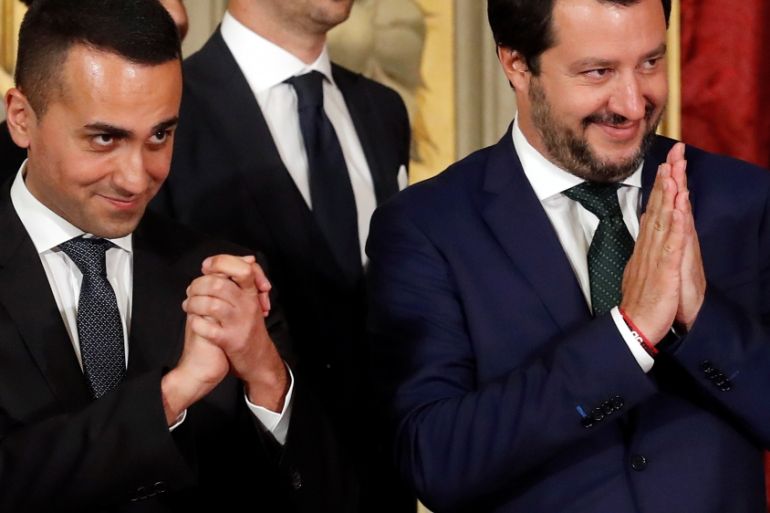National-populism: a new global model is born
The new model brings together fake social care, exacerbated nationalism and a compensatory pro-business approach.

History rarely repeats itself, but it often rhymes. Seen from Italy, the spectacle of far-right, pro-dictatorship Jair Bolsonaro winning the first round of Brazil’s presidential race rings very familiar bells.
In the 1920s, Italian fascism was initially resisted, and then supported, by economic elites. At first, a shunned and rowdy group, fascists were soon enough embraced by a self-interested establishment as the best defence against rising labour demands. National-socialism, the economic model crafted in Italy and perfected in Germany, combined a modicum of social concessions with iron-fisted protection for private property and industrial interests. This provided a blueprint that would be copied in dictatorships the world over.
Keep reading
list of 4 itemsShip that caused deadly Baltimore Key bridge collapse towed to port
‘Why should we vote?’ India’s jute workers blame politicians for woes
California farmworkers cheer new housing in town scarred by mass shooting
In 2016, a famously all-white, all-men soft coup in one of the world’s most diverse countries put to rest years of left-wing government in Brazil and brought to the fore the neoliberal boys of Michel Temer. Soon enough, Brazil’s socialist symbol, Lula de Silva, was imprisoned on charges tenuous at best and spurious at worst.
Two years later the result is Jair Bolsonaro, a nationalist populist strongman who combines popular support – what Temer desperately lacked – with support from a white economic establishment lured by his promises of social conservatism and extreme economic liberalism.
If Italian history helps to understand what is going on in Brazil, it is contemporary Italian politics that shows it as no Latin American oddity. Indeed, the recently elected Italian government – a coalition of the far-right League and the populist Five Star – seems to provide an almost perfect blueprint for a new global model: national-populism.
There are three main characteristics to such a model. The first is social protection. The first action of the new Italian government was meeting with representatives of one of the most exploited social groups: delivery workers in the gig economy. The next step was to pass a tightening of the labour law that was sold as “the end of precarity”. The third was to pass minimum income legislation sold as “the abolishment of poverty”.
Of course, nothing substantial has been done for gig economy workers, the labour law barely scraped the surface of the problem and the minimum income law was scaled back to a forced-labour programme that is among the harshest in Europe. But this is all about symbols. And after three decades of uninterrupted neoliberal hegemony symbols matter a great deal.
The second characteristic is nationalism. Surely, you might ask, the electorate will see through the fake socialism? This is where scapegoating comes in. The government has produced a witch-hunt that has led to repeated racist attacks across the country, the arrest of pro-refugee mayor Mimmo Lucano, and constant blaming of migrants for the country’s ills. And where migrants are not enough, there is the constant blame-game with the European Union. The government can’t do all that it promised? Too many migrants and too much EU.
The third characteristic is neoliberalism. The first budget law of the new government provides for a highly regressive flat tax – benefitting the richest – and large-scale impunity for tax dodgers. Observers expect the law to increase, rather than decrease, income inequalities. And while the remnants of the liberal establishment cry out against the government’s excessive budget deficit, the country’s many small and medium enterprises are lured and fall in line: beginning with the president of Italy’s union of industrialists.
National-populism brings together elements of fake social care, exacerbated nationalism and a compensatory pro-business approach. The model calls for a new grand bargain where social-sounding gestures accompany regressive taxation, while nationalism directs social anger away from an unjust economic system and towards the foreigner.
Panem et circenses – bread and circus – is how this model was called two thousand years earlier in ancient Rome. Give the people loaves of bread and a nationalist circus, and the economic elites can accumulate wealth with impunity. Today, the model rings a bell from Washington, DC, to New Delhi, from Manila to Brasilia.
The Italian experiment “will change global politics”, says former Trump aide Steve Bannon. The reasoning is clear. At a moment of global rebellion against “the elites”, any attempt to defend a system in crisis and maintain an untenable status quo – read Hillary Clinton, Angela Merkel or Emmanuel Macron – will only exacerbate the backlash and potentially lead to socialist demands gaining currency, as represented by Bernie Sanders in the US.
National-populism provides the magic stick to keep the revolting masses happy, the social body pacified, and capital accumulation continued. Exactly 10 years after the global economic crisis of 2008, nationalism comes to the rescue of neoliberalism.
The views expressed in this article are the author’s own and do not necessarily reflect Al Jazeera’s editorial stance.
